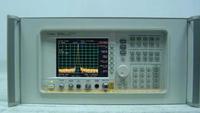Spectrum Analyzer English full name Spectrum Analyzer The main function of the system is to display the spectral characteristics of the input signal in the frequency domain. There are generally two types of spectrum analyzers based on signal processing methods: Real-Time Spectrum Analyzer and Sweep-Tuned Spectrum Analyzer. The function of the instantaneous frequency analyzer is to display the amplitude of the signal in the frequency domain at the same moment, and its working principle is different for different frequency signals. Corresponding filters and detectors are used. Signals are sent to display devices such as CRTs or liquid crystals via synchronous multiplex scanners. The advantage is that they display periodic spurious waves (Periodic Random Waves). The shortcomings of the transient response are that the price is expensive and the performance is limited by the bandwidth, the number of filters and the maximum switching time. The most commonly used spectrum analyzer is a sweep-tuned spectrum analyzer. Its basic structure is similar to a super-heterodyne receiver. The principle of operation is that the input signal is applied directly to the mixer through the attenuator, and the adjustable local oscillator is synchronized with the CRT. The sweep generator generates an oscillation frequency that changes linearly with time, is amplified by an intermediate frequency signal (IF) after being mixed by the mixer and the input signal, and filtered and transmitted to the vertical direction board of the CRT, so that the CRT The vertical axis shows the correspondence between signal amplitude and frequency. The important part that influences the signal response is the filter bandwidth. The characteristic of the filter is a Gaussian-Shaped filter. The function of the filter is the resolution bandwidth (RBW, ResolutionBandwidth) that is commonly found during measurement. RBW represents the difference of the minimum bandwidth that can be clearly distinguished between two signals with different frequencies. If the signal bandwidths of two different frequencies are lower than the RBW of the spectrum analyzer, the two signals will overlap and be difficult to distinguish. The RBW certainly helps with the resolution and measurement of signals at different frequencies. The low RBW will filter out the signal components at higher frequencies, causing distortion in the signal display. The distortion value is closely related to the set RBW, and the higher RBW is. Helps to detect broadband signals. It will increase the noise floor and reduce measurement sensitivity. It is easy to detect low-intensity signals. Therefore, proper RBW width is important for proper use of spectrum analyzers. the concept of. General maintenance personnel do not use, one is that his price is higher, and the other is that the operation is more complicated. Need to cooperate with the signal generator. But it is easy to use to find faults.
shandong lufan technical textile has production line of cotton canvas fabric,polyester canvas fabric,pvc coated tarpaulin fabric .all those fabrics could be processing to tarpaulin and covering .
Cotton Canvas Tarpaulin has the proprities of water resistant /uv resistant/breathbility etc .breathable is the biggest difference compare to the pvc coated tarpaulin .
pantone colors of pvc coated tarpaulin fabric fullfilled very easily .cotton canvas fabric is natural white color ,the special color requirments need to be accomplished after weaving .polyester canvas fabric has white /green/black etc .
Industrial Canvas Drop Tarpaulin Industrial Canvas Drop Tarpaulin,Canvas Drop Tarpaulin,Industry Cotton Canvas Tarps,Industrial Canvas Tarpaulin Shandong Lufan Technical Textiles Co.,LTD , https://www.lufan-tarps.com